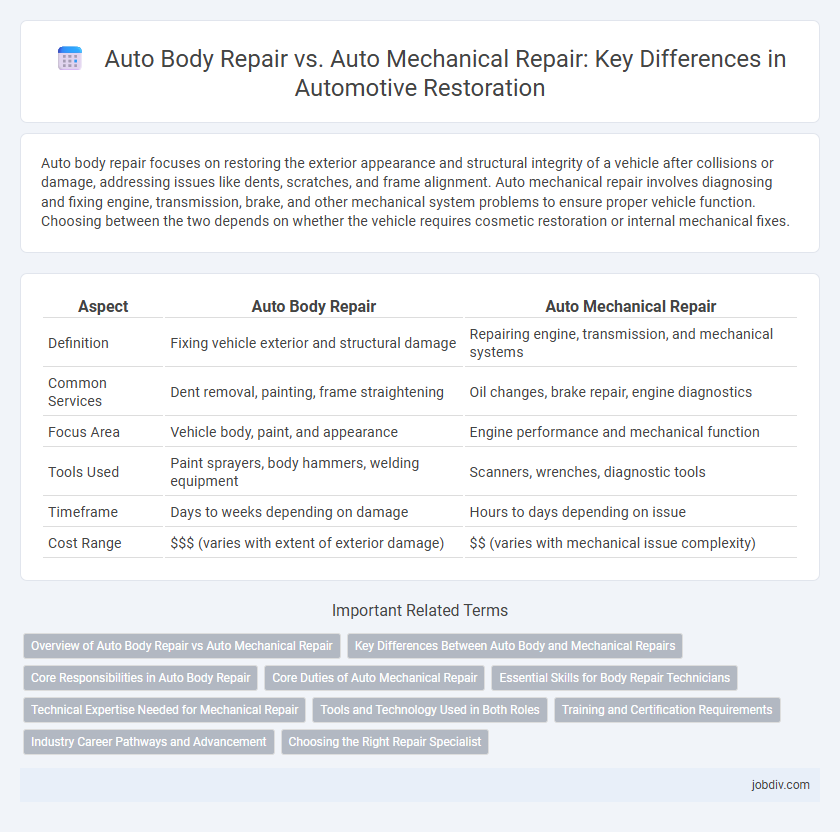Auto body repair focuses on restoring the exterior appearance and structural integrity of a vehicle after collisions or damage, addressing issues like dents, scratches, and frame alignment. Auto mechanical repair involves diagnosing and fixing engine, transmission, brake, and other mechanical system problems to ensure proper vehicle function. Choosing between the two depends on whether the vehicle requires cosmetic restoration or internal mechanical fixes.
Table of Comparison
| Aspect | Auto Body Repair | Auto Mechanical Repair |
|---|---|---|
| Definition | Fixing vehicle exterior and structural damage | Repairing engine, transmission, and mechanical systems |
| Common Services | Dent removal, painting, frame straightening | Oil changes, brake repair, engine diagnostics |
| Focus Area | Vehicle body, paint, and appearance | Engine performance and mechanical function |
| Tools Used | Paint sprayers, body hammers, welding equipment | Scanners, wrenches, diagnostic tools |
| Timeframe | Days to weeks depending on damage | Hours to days depending on issue |
| Cost Range | $$$ (varies with extent of exterior damage) | $$ (varies with mechanical issue complexity) |
Overview of Auto Body Repair vs Auto Mechanical Repair
Auto Body Repair primarily focuses on restoring a vehicle's exterior, including dent removal, paintwork, and frame alignment after collision damage, ensuring the car's aesthetic and structural integrity. Auto Mechanical Repair addresses the internal components such as the engine, transmission, brakes, and suspension, targeting performance issues and mechanical failures to maintain the vehicle's functionality. Both repair types are essential for comprehensive vehicle maintenance but specialize in distinct aspects of automotive care.
Key Differences Between Auto Body and Mechanical Repairs
Auto body repair focuses on restoring the vehicle's exterior appearance after collisions, including fixing dents, paint damage, and frame alignment, while auto mechanical repair addresses the internal mechanical components such as engine performance, brakes, and transmission systems. Body repairs often involve panel replacement, painting, and cosmetic refinishing, whereas mechanical repairs require diagnostics and replacement or repair of functional parts like belts, pumps, or sensors. Understanding the distinction helps in targeting expertise, tools, and processes specific to collision damage versus mechanical failures.
Core Responsibilities in Auto Body Repair
Auto body repair primarily involves restoring vehicle exteriors by repairing or replacing damaged panels, paintwork, bumpers, and frames to ensure structural integrity and aesthetic appearance. This specialization requires expertise in welding, dent removal, surface preparation, and refinishing techniques to return the vehicle to its original condition. Precision in matching paint colors and attention to detail in body alignment are critical to achieving seamless repairs and customer satisfaction.
Core Duties of Auto Mechanical Repair
Auto mechanical repair primarily focuses on diagnosing, servicing, and fixing the engine, transmission, brakes, and electrical systems of a vehicle. Technicians use specialized diagnostic tools to identify mechanical failures and perform tasks such as oil changes, brake replacements, engine tune-ups, and transmission repairs. Unlike auto body repair, which addresses cosmetic and structural damage, auto mechanical repair ensures that the vehicle operates safely and efficiently on the road.
Essential Skills for Body Repair Technicians
Body repair technicians must master skills such as dent removal, welding, panel replacement, and paint matching to restore vehicle exteriors to their original condition. Proficiency in using specialized tools like frame straighteners, airbrushes, and sanding machines is crucial for precision and durability. Knowledge of vehicle materials, corrosion resistance, and safety standards ensures effective damage repair while maintaining structural integrity and aesthetic appeal.
Technical Expertise Needed for Mechanical Repair
Auto mechanical repair demands specialized knowledge in engine diagnostics, transmission systems, and electronic control units, requiring technicians to master complex mechanical and computerized components. Precision in identifying and rectifying issues with fuel injection, exhaust systems, and braking mechanisms is essential for effective mechanical repair. Unlike auto body repair, which primarily focuses on cosmetic restoration, mechanical repair hinges on technical proficiency to ensure vehicle performance and safety.
Tools and Technology Used in Both Roles
Auto body repair primarily involves tools such as dent pullers, spray guns, and frame straightening machines to restore vehicle exteriors, while auto mechanical repair relies heavily on diagnostic scanners, wrenches, and engine analyzers for engine and transmission maintenance. Paint booths and sanding equipment are essential in auto body shops to achieve smooth finishes, whereas computerized diagnostic systems and hydraulic lifts are vital in mechanical repair for precise fault detection and efficient vehicle access. Advances in laser measuring systems benefit both fields by enhancing accuracy in structural repairs and alignment processes.
Training and Certification Requirements
Auto body repair technicians typically require specialized training in collision repair, painting, and frame straightening, often obtaining certifications from organizations like the National Institute for Automotive Service Excellence (ASE) in areas such as Collision Repair and Refinish. Auto mechanical repair professionals need in-depth knowledge of engine diagnostics, brake systems, and electrical components, with certifications emphasizing ASE Mechanical Repair specialties. Both fields demand continuous education to stay current with evolving automotive technologies and repair techniques.
Industry Career Pathways and Advancement
Auto body repair and auto mechanical repair offer distinct industry career pathways with specialized skill sets, where body repair focuses on restoring vehicle exteriors and mechanics concentrate on engine and system diagnostics. Advancement in auto body repair often leads to roles such as shop manager or estimator, while mechanical repair professionals can progress to master technician or service manager positions. Both fields demand continuous training and certification, including ASE credentials, to stay competitive and unlock higher earning potential.
Choosing the Right Repair Specialist
Auto body repair specialists focus on restoring a vehicle's exterior damage such as dents, scratches, and collision repairs, while auto mechanical repair experts handle engine performance, transmission issues, and brake system maintenance. Choosing the right repair specialist depends on accurately diagnosing whether the problem is cosmetic or functional. Properly matching the repair type ensures efficient service, preserves vehicle value, and enhances safety.
Auto Body Repair vs Auto Mechanical Repair Infographic

 jobdiv.com
jobdiv.com